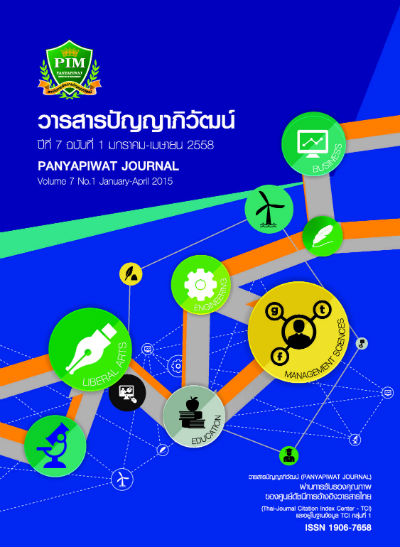TEACHERS’ AND STUDENTS’ PERCEPTIONS TOWARDS AN IN-HOUSE EFL TEXTBOOK
Main Article Content
บทคัดย่อ
Article Details
“ข้าพเจ้าและผู้เขียนร่วม (ถ้ามี) ขอรับรองว่า บทความที่เสนอมานี้ยังไม่เคยได้รับการตีพิมพ์และไม่ได้อยู่ระหว่างกระบวนการพิจารณาลงตีพิมพ์ในวารสารหรือแหล่งเผยแพร่อื่นใด ข้าพเจ้าและผู้เขียนร่วมยอมรับหลักเกณฑ์การพิจารณาต้นฉบับ ทั้งยินยอมให้กองบรรณาธิการมีสิทธิ์พิจารณาและตรวจแก้ต้นฉบับได้ตามที่เห็นสมควร พร้อมนี้ขอมอบลิขสิทธิ์บทความที่ได้รับการตีพิมพ์ให้แก่สถาบันการจัดการปัญญาภิวัฒน์หากมีการฟ้องร้องเรื่องการละเมิดลิขสิทธิ์เกี่ยวกับภาพ กราฟ ข้อความส่วนใดส่วนหนึ่งและ/หรือข้อคิดเห็นที่ปรากฏในบทความข้าพเจ้าและผู้เขียนร่วมยินยอมรับผิดชอบแต่เพียงฝ่ายเดียว”
References
Brinton, D. (2003). Content-based Instruction. In Nunan, D. (Ed.) Practical English language teaching. New York: McGrawHill.
Dörnyei, Z. (2007). Research methods in applied linguistics: Quantitative, qualitative and mixed methodologies. Oxford: Oxford University Press.
Fromkin, V. & Rodman, R. (1998). An Introduction to Language. (6th ed.). Florida: Harcourt Brace College Publisher.
Huang, W. J. & Shih, Y. (2009). An Evaluation of Junior High School English Textbooks in Taiwan. Fu Jen Studies: literature & linguistics, (42), 115.
Krashen, S. D. (1982). Principles and Practice in Second Language Acquisition. Retrieved April 20, 2011, from sdkrashen.com/Principles_and_Practice/Principles_and_ Practice.pdf
Lawrence, W. (2011). Textbook Evaluation: A Framework for Evaluating the Fitness of the Hong Kong New Secondary School (NSS) Curriculum. Unpublished master’s degree. City University of Hong Kong, Hong Kong.
McDonough, J. & Shaw, C. (2003). Materials and Methods in ELT, (2nd ed.). Victoria: Blackwell Publishing.
Miles, M. B. & Huberman, A. M. (1994). Qualitative Data Analysis: an Expanded Sourcebook, (2nd ed.). Thousand Oaks: SAGE Publications, Inc.
Saldana, J. (2009). The Coding Manual for Qualitative Researchers. New Delhi: SAGE Publications India Pvt. Ltd.Textbook Evaluation Instrument Based on the ACTFL Standards. (n.d.). Retrieved September 5, 2011, from http://documentsearch.org/pdf/actfl-textbook-evaluation-form.html
Tomlinson, B. & Masuhar H. (2004). Developing Language Course Materials. Singapore: SEAMEO Regional Language Center.
Tomlinson, B. & Masuhar H. (2010). Research for Materials Development in Language Learning: Evidence for Best Practice. Chennai: Replika Press Pvt. Ltd.
Wichitwarit, N. (2014). Essential elements contributing to the success of task-based implementation in an English classroom. Panyapiwat Journal, (5), 47-62.

